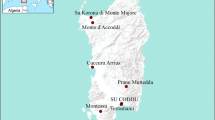Abstract
This paper discusses evidence related to the genesis and occurrence of mixed lead-tin ore deposit consisting of cassiterite and the secondary minerals formed from galena. These evidences belong to a very long time period ranging from pre-historic to as late as the nineteenth century a.d. This type of mixed ore deposits was smelted to prepare lead-tin alloys. The composition of the alloy depended on the composition of the starting ore mixture. A nineteenth century evidence for the production of directly smelted lead-tin alloys in southern Thailand is discussed. A unique and rather uncommon metallurgical terminology in Sanskrit language—Nāgaja—was introduced in India for the tin recovered from impure lead. This suggests that Indians developed a process for recovering tin from lead-tin alloys, which in all probability was based on the general principle of fire refining. It has been shown that in the context of India the possibility of connection between the word Nāgaja and the directly smelted lead-tin alloys cannot be ruled out.
Similar content being viewed by others
References
S.H. Abdullah and V.M. Chmyriov, editors, Geology and Mineral Resources of Afghanistan, Book 2 (Mineral Resources of Afghanistan) (London: British Geological Society, 2008), p. 149.
G.J. Orris and J.D. Bliss, Mines and Mineral Occurrences of Afghanistan, Open File Report 02-110 (Tucson, AZ: U.S. Geology Survey, 2002), p. 68.
G.J. Orris and J.D. Bliss, in Ref. 2, p. 64.
G.J. Orris and J.D. Bliss, in Ref. 2, p. 44.
Henry Louis, The Geographical Journal, 4(3) (1894), pp. 219–237.
Ivan Kostov, Mineralogy, First English edition (London: Oliver and Boyd, 1968), p. 155.
Kate Wright, Ian H. Hillier, David J. Vaughan, and Mark A. Vincent, Chemical Physics Letters, 299 (1999), pp. 527–531.
Extract from Report on the Tin Deposits of Taiping, Malay Peninsula, by Geologist to the Federated Malay States, 1904, in: Sydney Fawns, Tin Deposits of the World, II ed. (London: The Mining Journal, 1907), p. 75.
F.A. Genth, Proceedings of the American Philosophical Society, 24(125), 1887, pp. 23–44.
T.M. Babu, Tin in India (Bangalore: Geological Society of India, 1994), p. 59.
S.M. Gandhi, Rampura-Agucha Zinc-Lead Deposit (Bangalore: Geological Society of India, 2003), p. 22.
Henri Louis, in Ref. 5, p. 236.
F.A. Genth, in Ref. 9, pp. 25–26.
Hemacandrācārya, Abhidhāna Cintāmani, ed. Nemichandra Shastri and Hargovind Shastri (Varanasi, India: Chowkhamba Vidya Bhawan, 2003), p. 256.
Baladeva Upadhyaya, Sanskrit Sāstron Kā Itihāsa, II ed. (Varanasi, India: Sharda Mandir, 1983), p. 362.
O. Kubaschewski and C.B. Alcock, Metallurgical Thermochemistry, V ed. (Oxford: Pergamon Press, 1989).
Y.K. Rao, Stoichiometry and Thermodynamics of Metallurgical Processes (Cambridge: Cambridge University Press, 1985).
Brunei Pitis, http://en.wikipedia.org/wiki/Brunei_pitis .
R.F Tylecote, Metallurgy in Archaeology (London: Edward Arnold, 1962), p. 69.
Christopher P. Thornton, C.C. Lamberg-Karlovsky, Marin Liezers, and Suzanne M.M. Young, J. of Archaeological Science, 29 (2002), pp. 1451–1460.
Pliny, Natural History, Book VI, (tr.) H. Rackham, First published in 1942, Reprint ed. (Cambridge, MA: Harvard University Press, 1989), p. 397.
Bharat Singh Upadhyaya, Buddha Kālīna Bhūgola (Allahabad, India: Hindi Sahitya Sammelana, 1961), p. 62.
D.R. Bhandarkar, Lectures on the Ancient History of India on the period from 650 to 325 B.C., First published (Kolkata, India: University of Calcutta, 1919), Reprint ed. (New Delhi: Asian Educational Services, 1944), p. 54.
B.C. Law, Historical Geography of Ancient India, Second and revised edition with Avant-propos by Louis Renou (Paris: Société Asiatique de Paris, 1967), p. 158.
D.C. Sircar, Studies in the Geography of Ancient and Medieval India (New Delhi: Motilal Banarasidass, 1971), p. 236.
P.C. Prasad, Foreign Trade and Commerce in Ancient India (New Delhi: Abhinav Publications, 1977), p. 66.
R.K. Dube, Bulletin of the Metals Museum, 36 (2003), pp. 3–22.
Paul Wheatley, The Golden Khersonese (Kuala Lumpur, India: University of Malay Press, 1961).
R.C. Majumdar, Suvarnadvīpa: Ancient Indian Colonies in the Far East, First published in 1927, Reprint edition (New Delhi: Gian Publishing House, 1986).
Brian Harrison, South East Asia (London: McMillan & Co., 1964), p. 10.
H.G. Quartich Wales, J. of the Malayan Branch of the Royal Asiatic Society, 18 (1940), pp. 1–85, cited in: Buddha Prakash, India and the World (Hoshiarpur: V.V. Research Institute, 1964), p. 57.
Z. Ramli, N.H. Shuhaimi, and N.A. Rahman, European J. of Social Sciences, 10(4) (2009), p. 585.
A.S. Gupta, editor, Vāmana Purāna (Varanasi, India: All India Kasiraja Trust, 1968), p. 61.
Haribhadra Suri, Samaraiccakahā, Vol. 1, ed. Ramesh Chandra Jain (New Delhi: Bhartiya Gyanapith Publications, 1993), p. 398.
Somadeva, Kathāsaritsāgara, Vol. 3, (tr.) J.S. Jha and P.C. Ojha (Patna, India: Bihar Rashtra Bhasha Parishad, 1973), p. 1142.
Author information
Authors and Affiliations
Corresponding author
Rights and permissions
About this article
Cite this article
Dube, R.K. Directly smelted lead-tin alloys: A historical perspective. JOM 62, 13–18 (2010). https://doi.org/10.1007/s11837-010-0118-3
Published:
Issue Date:
DOI: https://doi.org/10.1007/s11837-010-0118-3




